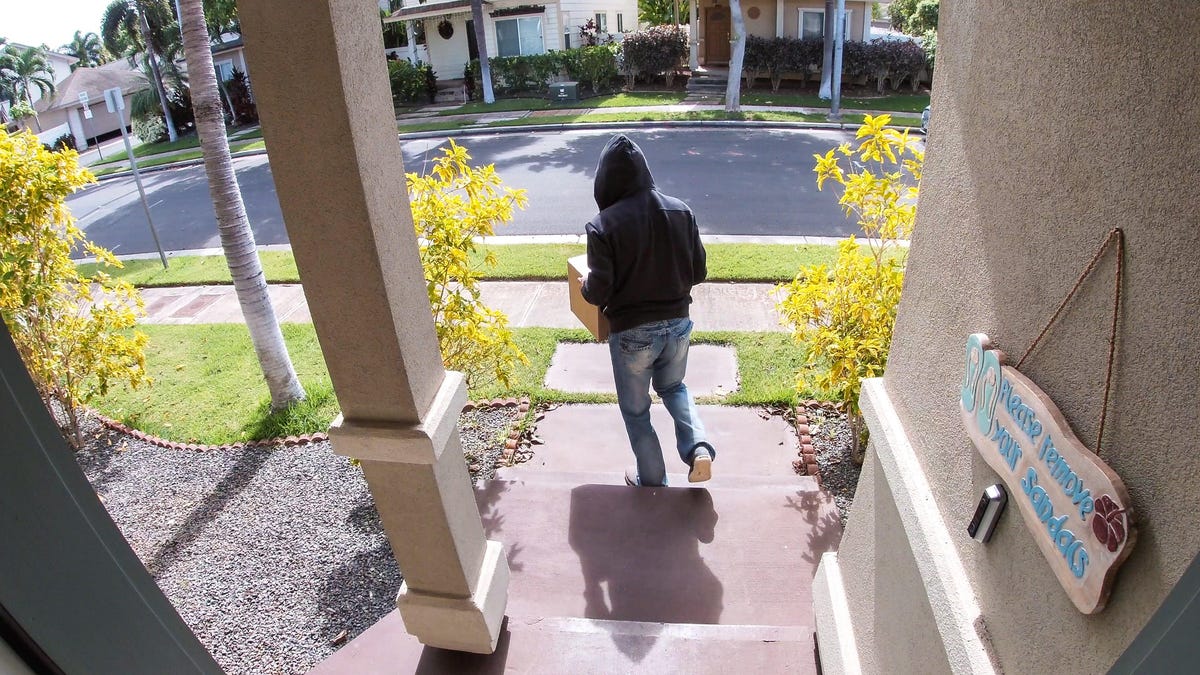[ad_1]

Most folks who have ever purchased something from an online retailer or meal kit service have probably experienced—or at least feared—package theft. Even if you’re extra careful about tracking your packages and you’ve never had a package stolen from your front steps or porch, you’ve probably gone through the anxiety of getting a delivery confirmation when you know you won’t be home for some time, leaving your valuable package exposed to Porch Pirates.
Because it’s a relatively low-risk and low-effort crime, package theft is pretty rampant. A study concluded that in 2022 14% of us have had a package stolen at least once, with an average value of about $112—which is nothing to sneeze at. As more and more shopping is being done online, this problem isn’t going away any time soon. While it’s pretty clear what to do after your package is gone, you’re also going to need to figure out a way to stop—or at least slow down—the jolly Porch Pirates operating in your area. Here’s how to do that.
Change the location
The easiest and most effective way to keep Porch Pirates from your loot is to have it delivered someplace other than your empty, undefended house. If you have a lot of packages delivered and you’re rarely home to receive them, you should consider establishing a permanent alternative to your front door and start using that as your default delivery address. You have a few options here:
- An alternative address. Have your packages delivered someplace other than your home. This could be a neighbor or nearby family member who is home to accept packages or even your job as long as you can easily cart packages home after work. Some retailers like Amazon also offer alternative pickup locations through programs like Amazon Locker, so it can be worth your while to check and see if you can have the delivery routed to one of those locations instead.
- A package-receiving service. Depending on where you live, you might be able to sign up for a package-receiving service like GoLocker. These services accept your packages for you and hold them until you can pick them up—or even deliver them to you at a later time.
- Allow in-home deliveries. Many online retailers have launched programs that let you give their delivery people access to your garage, if you have one. Amazon Key and Walmart’s InHome programs work similarly, for example: You install a Smart garage control system (at your cost) and give the retailer access. Their delivery folks can open your garage, drop off your stuff, and then close everything up. Obviously, you’ll have to be pretty comfortable with having randos part of your house.
Use every tracking option
When you order something online, you generally have a lot of options for tracking your package. Almost any delivery will offer at least the basic delivery notification that gets triggered when your package is dropped off, but many services allow you to track your package closer to real-time, showing the truck on a map as it moves through your area. Signing up for every tracking option available—email and texts, for example—and keeping the app or website live on your phone or computer will give you a very good idea of when your package is scheduled to arrive, so you can make arrangements to have someone there to receive it.
G/O Media may get a commission

Up to $100 credit
Samsung Reserve
Reserve the next gen Samsung device
All you need to do is sign up with your email and boom: credit for your preorder on a new Samsung device.
Something else you can do when ordering is to add very specific instructions to your delivery person. These could include a specific hiding place for your packages or a slightly unexpected delivery location, like a side door. You can’t guarantee your instructions will be followed, but it doesn’t hurt to try.
Band together
We live in a society, and sometimes humans just have to be bros to each other. Are there folks in your neighborhood who work from home or just happen to be around all day? They might be willing to receive packages on your behalf. Even if you don’t feel comfortable doing that, if you get your block set up on a mailing list or an app like NextDoor, everyone can chip in and grab packages if they see them sitting out in front of your house. My wife and I have become more or less the Unofficial Package Managers of our neighborhood because we’ve been working remotely for years, and our neighbors know we’re happy to run across the street and grab a package almost any time. In other words, sometimes all you need is a friend or two.
Cameras and security
Finally, and most obviously for many, you can trick out your front porch to discourage or prevent package theft as much as possible. While a determined (and/or desperate) Porch Pirate might ignore or even circumvent some of these measures, they’re certainly worth setting up if you know you’re a potential target. These include:
- Home security systems. Whether it’s a SimpliSafe or ADT system or similar, you can wire up your house to not only set off an alarm when people disturb your front porch, but to also send you a text or email alert when it happens. Some systems will also allow you to tap into a video feed and even speak to whoever’s on your porch, which might scare them away. Ring doorbells and similar products can offer a similar ability to be alerted when someone’s at your front door and even see and speak to them.
- Motion-activated lights. If you’re forced to let packages sit overnight, or the sun is setting early where you live, having a floodlight that pops on when people approach can discourage a wide range of sketchy behavior.
- Security bags and boxes. There are a lot of security bags and boxes you can purchase, like this Porch Pirate Bag. They all work essentially the same way: They’re secured somehow to your house (via bolts or heavy wire), the delivery person places packages inside, then locks them. While a very determined thief could possibly smash them open, that’s a lot more work—and a lot more noise and trouble—than most would be willing to risk.
This is the age of the endless delivery, so it’s time to up your game and make some plans to protect the stuff you paid for. Your only other option is to go back in time and start shopping at actual stores only when you have time, which sounds horrifying.
Source link

